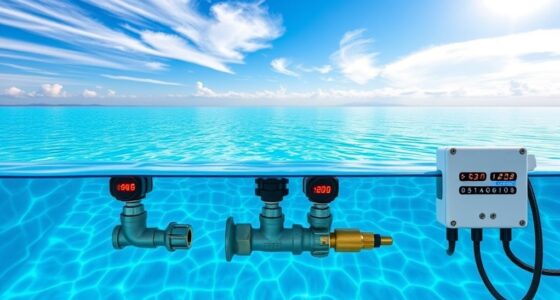To care for your infinity pool in cold regions, start by thoroughly cleaning and balancing the water chemistry. Lower the water level below the skimmer, run the pump periodically, and add winterizing chemicals to prevent algae. Protect the surface and surrounding area with a sturdy cover, and guarantee all equipment is drained or antifreezed. Regular checks and proper insulation keep your pool safe through winter. Keep going to discover the essential steps for a smooth off-season and reopening.
Key Takeaways
- Lower water levels below the skimmer and jets to prevent freezing damage during winter.
- Use a high-quality, weatherproof cover and secure it tightly to keep out snow, ice, and debris.
- Maintain regular circulation with a small pump or aerator to prevent stagnation and algae growth.
- Drain residual water from pipes and equipment, and add antifreeze if recommended by the manufacturer.
- Conduct routine inspections of the cover and pool surrounds to address damage or debris buildup promptly.
Preparing Your Infinity Pool for Winterization
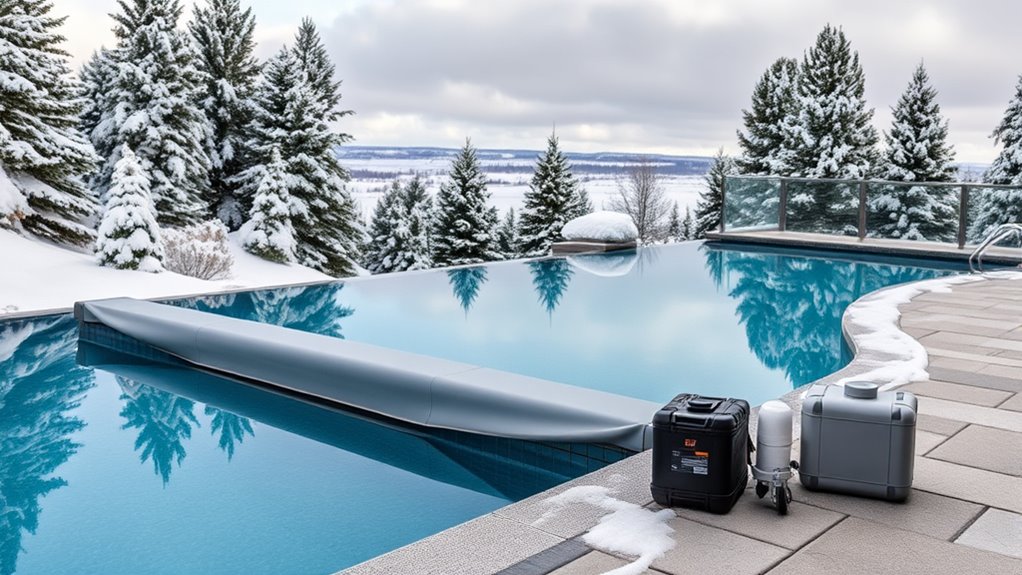
As winter approaches, it’s essential to properly prepare your infinity pool for the off-season to safeguard against damage and ensure easy reopening in the spring. Start by thoroughly cleaning the pool, removing debris, leaves, and dirt to prevent stains and algae growth. Test and balance the water’s pH, alkalinity, and calcium hardness, then add winterizing chemicals to inhibit algae and bacteria. Lower the water level below the skimmer and jets to prevent freezing damage. Drain all equipment, such as pumps and filters, or add antifreeze if recommended by your manufacturer. Cover the pool securely with a high-quality winter cover to keep out debris and prevent ice buildup. Proper winterization protects your pool’s integrity and simplifies the opening process when warmer weather returns. Additionally, consider electric pool heaters if you plan to use your pool during colder months, as they can help maintain water temperature and prevent freezing issues.
Protecting the Pool Structure and Surroundings
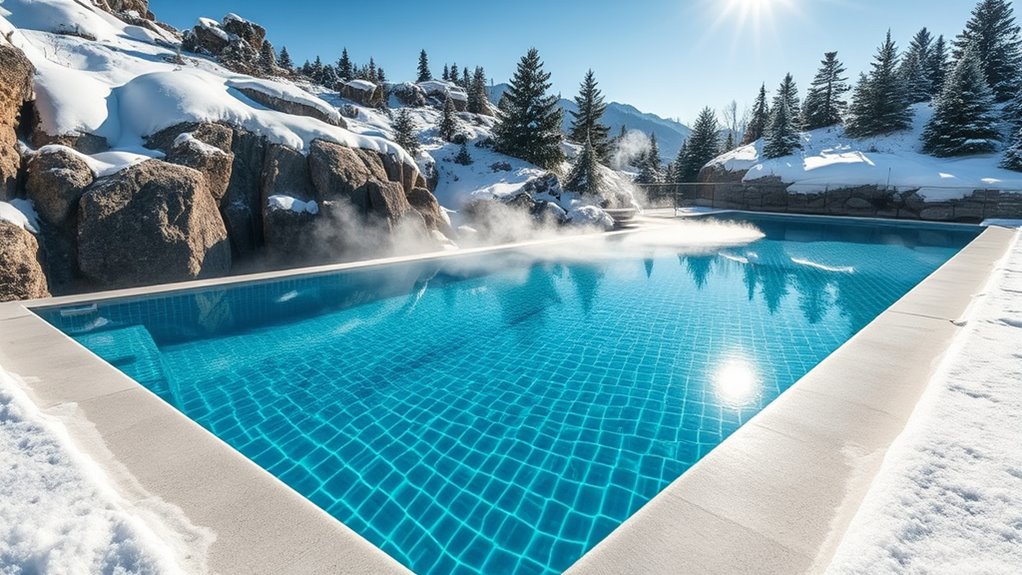
To guarantee your infinity pool remains in top condition during the off-season, you need to focus on protecting both the pool structure and its surroundings. Start by inspecting the pool’s edges and surface for cracks or damage, repairing any issues before winter. Clear debris from the deck and ensure the area around the pool is free of leaves, dirt, and plants that could cause staining or damage. Cover exposed surfaces with protective materials to prevent frost-related cracking or erosion. Trim nearby trees and shrubs to reduce debris and prevent damage from falling branches. Install barriers or fencing if needed to keep out animals or harsh weather elements. Properly securing the surroundings helps maintain the integrity of your pool and reduces the risk of costly repairs come spring. Additionally, using appropriate covering materials can further protect your pool from harsh weather conditions.
Managing Water Levels and Circulation During Cold Months
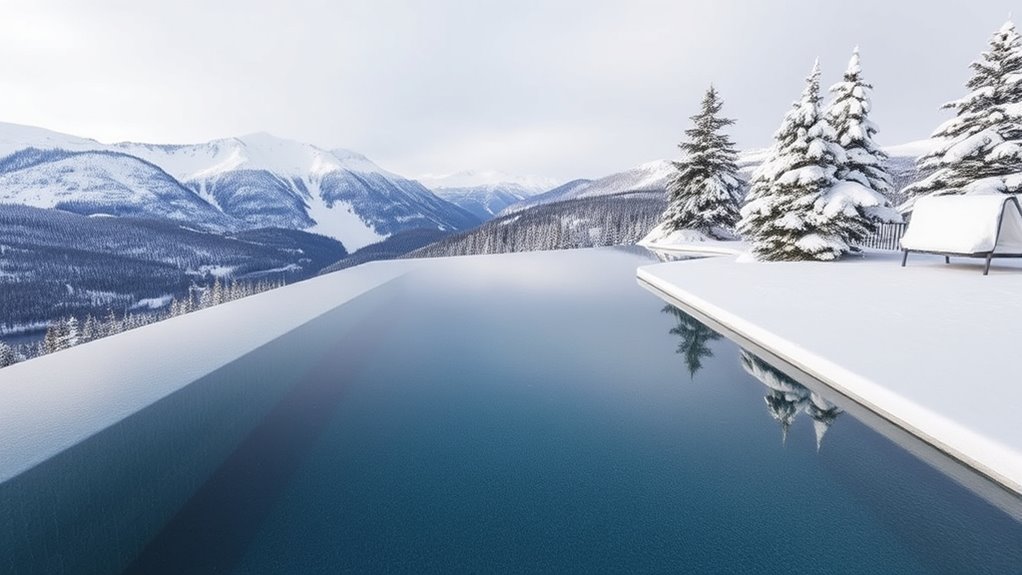
Properly managing water levels and circulation is key to protecting your infinity pool during the colder months. You want to keep the water level just below the skimmer opening to prevent ice formation and reduce stress on the structure. Running the pump regularly helps maintain proper circulation, which prevents stagnant water and reduces the risk of freezing. Set your pump to operate for a few hours each day, even if you’re not using the pool frequently. This circulation ensures the water stays moving and minimizes ice buildup. Also, consider lowering the water level slightly to account for evaporation and to avoid overflow if freezing causes expansion. By actively manage these aspects, you safeguard your pool’s integrity throughout the winter. Remember, water temperature plays a crucial role in preventing ice formation and should be monitored carefully.
Covering and Insulating the Pool Effectively
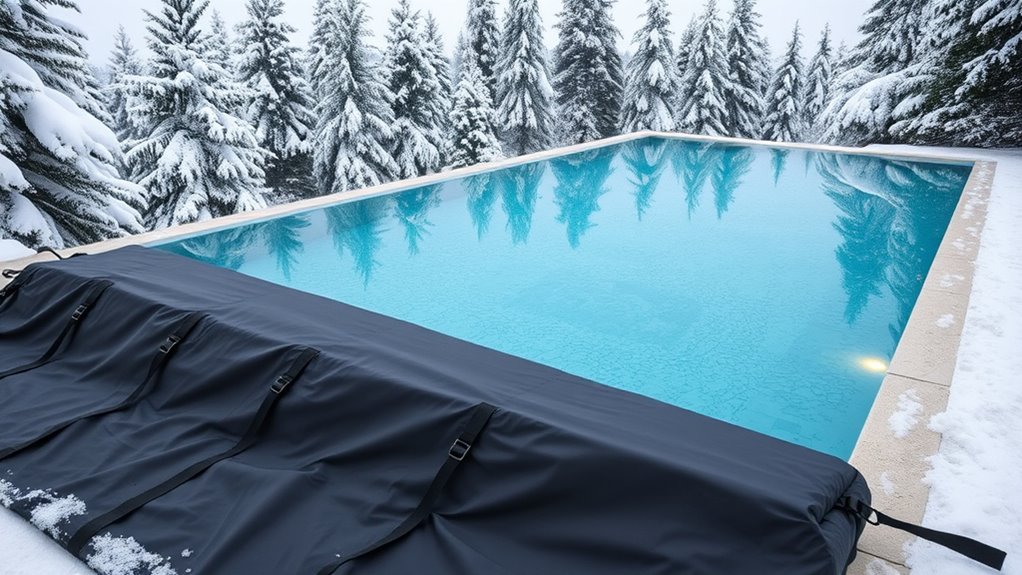
Covering and insulating your infinity pool is vital for protecting it from winter weather and preventing heat loss. A high-quality, weatherproof cover keeps snow, ice, and debris out, reducing the risk of damage and algae growth. Make certain the cover is snug and securely anchored to withstand winter winds. Insulation plays a key role in maintaining water temperature; foam panels or thermal blankets help retain heat and minimize energy costs. You can also add a bubble cover or solar blanket to further insulate the surface. Proper covering and insulation prevent costly repairs and guarantee your pool stays in good condition until you’re ready to reopen it. Regularly check the cover’s integrity throughout winter to catch any damage early.
Maintaining Water Quality Throughout the Off-Season
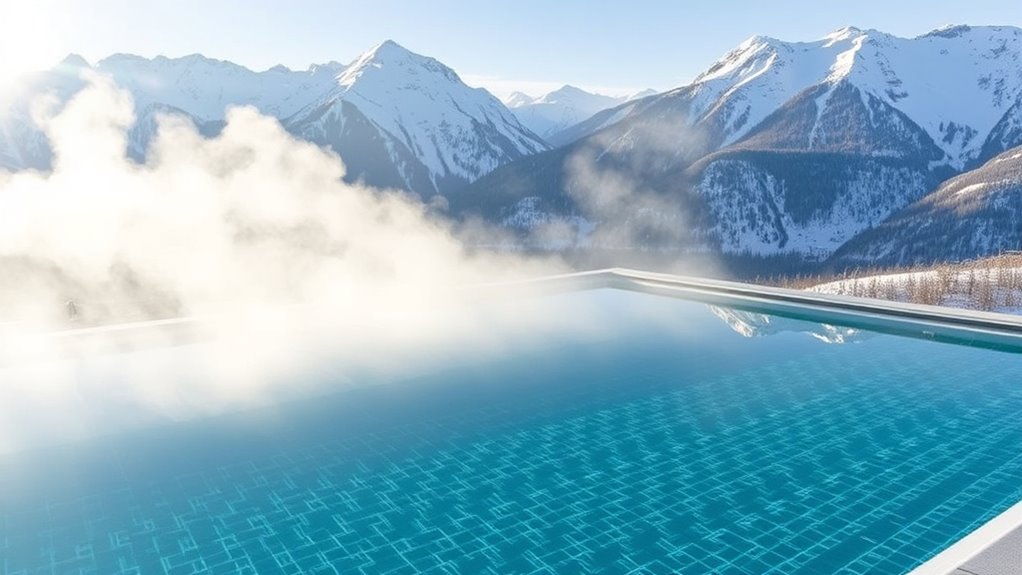
Even when your infinity pool is closed for the season, maintaining water quality remains essential to prevent algae growth, corrosion, and staining. To guarantee this, regularly check and adjust the water’s pH and sanitizer levels. Use a pool algaecide to inhibit algae development, especially in colder months. Keep the water circulating with a small pump or aerator to prevent stagnation, and drain any residual water from pipes and equipment to avoid freezing damage. Additionally, remove debris and leaves from the water and cover the pool securely. Monitoring water chemistry weekly helps ensure optimal conditions and prevents issues caused by imbalanced water.
Restarting and Opening Your Infinity Pool for the New Season
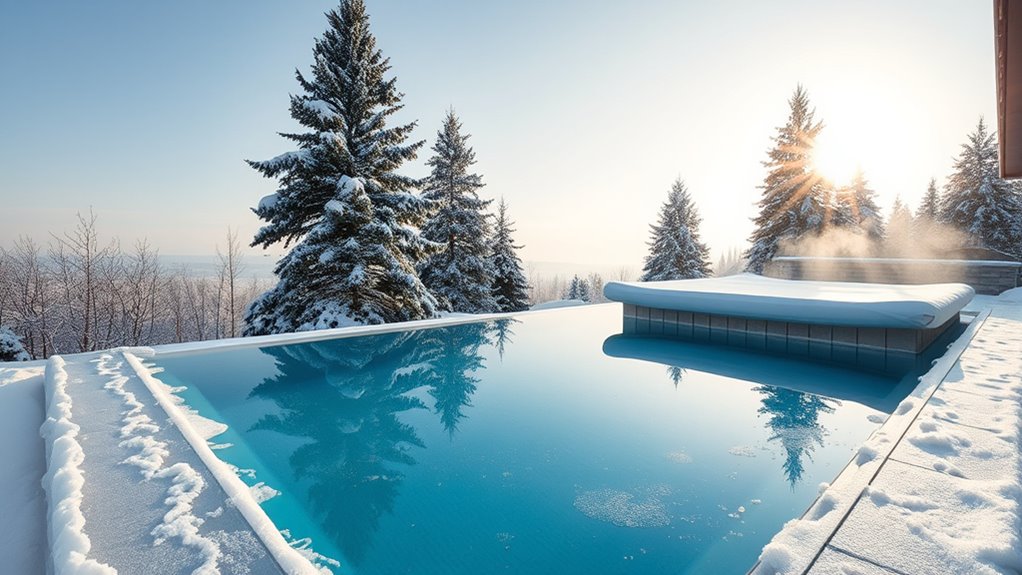
To get your infinity pool ready for the new season, start by draining and cleaning it thoroughly. Next, inspect your equipment for any damage and make necessary repairs to make certain everything functions smoothly. Efficient equipment is essential for maintaining optimal performance and energy savings throughout the season. Finally, refill the pool and balance the water chemistry before enjoying your refreshed oasis.
Drain and Clean Pool
Before opening your infinity pool for the new season, draining any remaining water and giving it a thorough cleaning is vital. Start by removing all water using a submersible pump or drain plug. Once empty, scrub the surfaces with a non-abrasive cleaner to remove dirt, algae, and debris. Check the pool lining for any signs of damage or wear. Finally, rinse thoroughly to guarantee no residue remains. To make this process smoother, consider:
- Removing and cleaning skimmer baskets and filters
- Inspecting the pool’s interior for cracks or tears
- Clearing out any debris from the drain and skimmer areas
- Checking for mold or algae buildup and treating accordingly
- Ensuring proper water chemistry for a safe and clean restart
A clean pool ensures better water quality and makes the opening process easier and more effective.
Inspect and Repair Equipment
Have you checked your pool equipment lately to make certain everything is functioning properly? Start by inspecting your pump, filter, and heater for any signs of damage or wear. Ensure all hoses and fittings are secure, and look for leaks or cracks. Turn on the equipment to see if it operates smoothly without unusual noises or vibrations. Clean out the skimmer and pump baskets to prevent blockages. Test the electrical connections and reset any tripped breakers. If you notice corrosion, cracks, or faulty parts, replace or repair them before opening your pool fully. Properly functioning equipment guarantees your infinity pool will operate efficiently and safely once you refill and balance the water. Regular inspection now prevents costly repairs later.
Refill and Balance Water
Once you’ve inspected and repaired your equipment, it’s time to refill your infinity pool and bring the water back to ideal levels. Start by adding water gradually, monitoring the level to prevent overflow. Next, test the water’s chemistry, including pH, alkalinity, and sanitizer levels, adjusting as necessary. Proper balancing ensures clear, safe water and protects your pool’s surfaces. To assist, consider these steps:
- Use a reliable test kit to measure water parameters accurately
- Add pH increaser or decreaser to reach the ideal range
- Shock the pool if algae or contaminants are present
- Circulate the water thoroughly to distribute chemicals evenly
- Regularly monitor water conditions to maintain optimal water chemistry and ensure long-term pool health
Balancing your water ensures a safe, inviting pool for the season ahead.
Frequently Asked Questions
How Often Should I Check My Infinity Pool During Winter?
You should check your infinity pool at least once a week during winter. Regular inspections help you spot issues like freezing pipes, debris buildup, or chemical imbalances early. Keep an eye on the water level and temperature, and clear any leaves or debris from the surface. Consistent checks make certain your pool stays in good condition and prevents costly damage, making sure it’s ready for use when spring arrives.
Are There Specific Chemicals Recommended for Winter Water Treatment?
Did you know that untreated winter water can contain bacteria levels up to 10 times higher? You should use a winter-specific sanitizer, like a bromine or chlorine shock, to keep your pool clear and safe. Add stabilizers and algaecides designed for cold weather, and always test your water regularly. This guarantees your pool stays balanced, preventing damage and making spring opening much easier.
Can Wildlife Damage the Pool Cover in Cold Regions?
Wildlife can damage your pool cover in cold regions, especially if animals see it as shelter or a food source. You might notice animals like raccoons, deer, or rodents trying to get under or onto the cover. To prevent this, secure the cover tightly, use wildlife deterrents nearby, and clear away food or trash that might attract animals. Regular inspections help catch any damage early before it worsens.
What Are Common Signs of Winter Damage to the Pool?
You’ll notice winter damage to your pool if you see cracks, leaks, or warped surfaces on the pool shell. Frozen water can cause ice expansion, leading to structural issues. Additionally, check for damaged or torn covers, clogged skimmers, and broken or frozen plumbing lines. Unusual water levels or cloudy, discolored water can also indicate underlying damage. Regular inspections help catch these signs early, preventing costly repairs.
Is Professional Winterization Necessary for All Types of Infinity Pools?
Like a delicate sculpture, your infinity pool needs careful winterization, but not all types require a professional touch. If you have a standard or vinyl-lined infinity pool, you can often winterize it yourself with proper guidance. However, for complex or high-end designs, a professional guarantees thorough protection against freezing damage. You’ll want expert help to avoid costly repairs and keep your pool pristine for the seasons ahead.
Conclusion
So, now you’re all set to turn your breathtaking infinity pool into a winter wonderland—or perhaps just a frozen art installation. With a little effort, you’ll avoid the chaos of a cracked shell or algae invasion, and instead, enjoy a pristine basin ready to dazzle next season. Who knew that protecting your luxury splash zone could be so rewarding? Just think—next summer, you’ll be the envy of every snowbird and pool owner alike.


